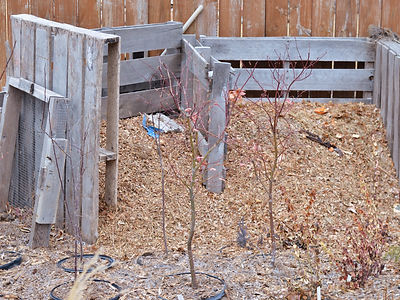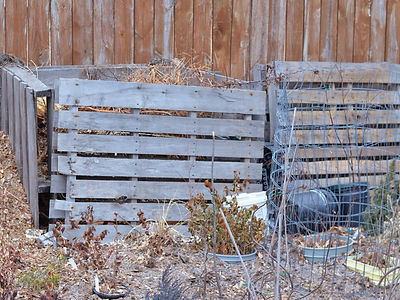
Steadfast Nursery
Homegrown Perennials, shrubs and small landscape trees
Grown right here in Lincoln, NE
Composting for Dummies
I was a dummy when I started composting. I believed that one needed a ridiculously expensive composter or the utterly complex decomposition of composting would be disrupted by my simpleton ineptitude. I thought that everything could be composted because it is essentially of the ground. I underthought the reality of vermin and overthought the ratios. I misunderstood the principles and thought I could outwit the process of decay. The argument could be made with success that I am still stupid about many things, but this is no longer one of them. Why, you say? I failed too much not to learn and I've learned too much not to fail. Wait, what was that? Just keep reading.
Come with me on a fantastic voyage called composting. Learn from my boneheadedness so you too can be a less dummified composter. Who knows? Maybe you too will find simple joy in stealing other people's banana peels and releasing your politically induced stress by turning a pile of rotting organic matter. Yes, you just might find your inner nerdiness when you get a whiff of turned salad mixed with decaying leaves or watermelon rinds cohabitating with used potting soil. Maybe you'll discover not that you enjoy the blissful putrifaction of organic has-beens but that wierdos out there actually like this stuff (and just might skip out on social interactions to turn their stinking piles).
It is a strange obsession, but not a harmful one. No one I'm aware of has ever been arrested for composting to excess or locked up for recycling earth products (though I can't speak for those living in the Hamptons). Let's be simple. Allow me to break down how to break down the junk you already have in your home and garden and turn it into the mysterious black gold which is not always black and contains no gold.
Compost piles are unlike expensive pergolas or cozy firepits. They can be unsitely unless one wants to take the time and money to build a small cabin for your plant prunings, torn cardboard, shredded newspaper and coffee grounds complete with a pool and diving board for squirrels. Find a location at your home or business where neighbors won't get the pleasure of smelling putrified cantalope rinds mixing with sawdust and grass clippings and your dinner guests won't be staring down dead weeds and last weeks tossed salad. Location is important. Your spot should be convenient, accessible and close to a water source (explained later) or you won't be trotting out to donate leftover cucumber slices in your bath robe and jammie pants.
As you see, I use free pallets. Just three screwed together will yield a nice, cheap way to pile up your garden scraps. I then lean another pallet in front when the pile gets big to keep stuff from falling out. You can innovate and come up with a hinged door or a pin system to keep it in place. I like it simple. Less talk, more rock. Can raccoons or sasquatches knock over the pallet if it just leaned against the bin? Yessir, but easy is my jam. You don't need a $450 compost tumbler to start composting (though if anyone has a spare one laying around, I would be happy to take it off your hands and free up some space for you). If nothing else, you can just start heaping it into a pile. Just a pile? No way that would work, right? Wrong. It has been happening since the beginning. Leaves fall and pile up. Leaves start decomposing. Eventually, BAM, compost. It's that simple.
Say WHAT WHAT? This is where people get all flustered, including my old self. What to put in, how much to put in, what tax form to use. It can all get confusing. Let's keep it simple. You need greens and browns. Don't get too caught up in color. It's more a classification than a color. Greens have nitrogen. Browns have carbon. You need both or your pile will be dead or a collapsed pile of goo. Don't get discombobulated over ratios and percentages. Just remember you need greens and browns.
In the bottom of your pile, start by laying down a layer of cardboard. Not cardboard with color pictures, just plain O' cardboard. Next, throw in a layer of shredded newspaper (without ads), shredded cardboard, corn cobs, used tea leaves, coffee grounds, shredded leaves, wood chips, shop sawdust, used potting soil, a shovel full of garden soil, dryed out corn husks or dry brown grass clippings. This is a layer of browns. Now on top of that, add a layer of greens like turned salad, shrub prunings, weeds without seedheads, potato peelings, carrot peelings, cucumber peelings, apple cores, apple skins, orange peels, spent pumpkins, watermelon rinds, cantalope rinds, banana peels, corn husks, spoiled fruit, pineapple rind and core, rhubarb leaves after harvesting stems, etc. Don't worry if you have mold on the greens you add. That is kind of the point. Greens and browns, gotta have them. You have two layers, now add more. Everytime you add a layer of browns, add a layer of greens and vice versa. It's not about ratios, its about layers. Ogres have layers, compost has layers. Capiche?
DO NOT ADD:
Diseased leaves, stems or fruit from infected plants. Grass clippings from a lawn treated with weed killer. Meat or dairy products. Bread (unless a closed system like a compost tumbler). Newspaper ads or any shiny paper like magazines. White or colored paper products (newspaper is different than white paper, white paper uses chemicals and bleach to achieve its affect not to mention it takes forever to break down). Oil, gas, or chemicals of any kind. Grass or weed killer. If you notice vermin, be conscious of what you put in and the abundance. I have started to put vermin attracting veggie scraps in a bag to start decomposing before adding to the pile. I don't need any more visitors than I already have.
Your pile needs greens, browns, air and water to be effective. You don't need to use precious faucet water if you have other means of collecting it like rain barrels or even buckets set out during rainfall or placed under downspouts (yup, done that). A moist pile is alive and breaking down. A dead, dry pile is a piece of junk. Note: If you have too many greens and not enough browns, adding moisture will collapse your pile into a stinky, gooey mess. If this happens, fret not, add browns and turn the pile. Your pile should have the feel of a wrung out sponge.
What? How is that a step? Turn it or not? Here is your choice. Hot composting happens when air is introduced to a moist pile frequently. In my early days of youthful back ease, I turned my pile weekly. You could see the steam coming off of it even in the heat of summer. It was glorious. Nowadays, I value my time so I opt for cold composting. My time is spent layering, then waiting. Instead of harvesting compost three times a year, I now only harvest once or twice. It breaks down the same, just more slowly. I will turn it once or twice a season with success.
--Keep adding during the winter. I get better composting during the winter than during the year because of the freeze thaw cycle. Your pile might break down by half during the winter (depending on the winter).
--When you harvest compost, start your next pile by taking stuff that isn't fully broken down and adding it to the next pile. It is helpful to have a second bin for this reason. By adding partially broken down material, you will supercharge the next round with microbes and quicken the process.
--Don't buy compost activator, it is a waste of money (unless they want to sponsor me, then they are wonderfully effective). Just throw a shovel full of garden soil in your compost, it accomplishes the same means.
--Keep a lidded coffee container in your kitchen to collect scraps. They will seal out the horribly wonderful odor and keep you from trekking out to the pile for every little thing.
--This tip is super gross. Just letting you know. If your compost is moist and layered with greens and browns, but still is lagging, apply urine. Wait, wait, wait. That is nasty. Yes it is, but it works...really well to supercharge your compost. Don't just take a leak on your pile for the sake of your neighbors and all goodness! Collect it in private manner and apply it to your pile. Skip this step if it is just too much for you.
On that glorious day when your hard work has been rewarded, you will have a conundrum. What to do with your compost? I had a friend donate two yards of unfinished compost to me. I laughed as I looked at their sad yard in need of a feeding. I took it anyway and gloried in my treasure. Every plant you plant, add compost to the soil mixture you add back to the hole. Top dress your plants (garden speak for put it around the top of the plant). Seep it in water then add that water to veggie or garden plants (this is called compost tea). Sell it and make millions of yen. Spread it around your garden for huge, veggies! When you compost, you'll never have enough!
I hope you have been enlightened, empowered and want to give me tons of money for the knowledge bestowed upon your cranium. Make this year the year you compost and save the world (at least your yard and garden!)
Step One of Eighty Three: Find a good location to compost.



As you can see from these bastions of composting glory that they set no standard for attractiveness and garden architecture. They are useful and cheap. The picture on the left is a composter I made out of two tubs bolted together. I use this composter for materials prone to attract vermin. They are located in a corner of my backyard nursery which is both convenient and out of site. I have indeed dropped off tidbits in my bath robe no doubt to the horror of my neigbors.